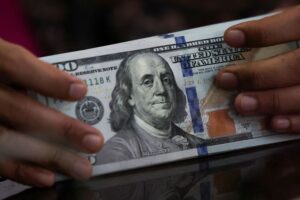The Dollar’s Decline: A Deep Dive into Recent Trends and Future Implications
Recent market dynamics reveal a significant shift in the performance of the U.S. dollar, amplifying concerns among investors about its stability as a global currency. The greenback has depreciated against major currencies, reaching a decade-low against the Swiss franc and a three-year low against the euro. This trend has sparked a renewed debate about the global financial system and the positioning of currencies within it.
Tariff Troubles and Market Reactions
On the backdrop of escalating trade tensions, China has raised tariffs on U.S. imports to an extraordinary 125%, up from 84%, in response to President Trump’s decision to hike duties on Chinese goods to 145%. This tit-for-tat exchange is creating ripples in investor sentiment, amplifying fears surrounding the safety and reliability of the dollar as a reserve currency.
As the global selloff accelerates, equities are not the only frightened asset class; even safe-haven U.S. Treasuries are feeling the heat. We are witnessing the benchmark 10-year Treasury yields poised for their largest weekly jump since 2001, reflecting investor distress.
A Shift in Currency Confidence
Brad Bechtel, the global head of FX at Jefferies, offers insight into the prevailing atmosphere among investors. He suggests a growing perception of waning U.S. economic dominance, coupled with fears of a potential recession, is contributing to the dollar’s depreciation. “There’s a great rotation happening,” he states, describing how foreign investors are diversifying portfolios away from the U.S. and seeking refuge in currencies such as the euro.
This highlights an emerging trend where investors remain entangled in the U.S. market yet realize the pressing necessity of currency hedging. This trend, combined with significant volatility in global markets, has added further pressure on the dollar’s value.
Economic Indicators and Market Moves
Economic indicators released recently paint a troubling picture for the U.S. economy, with consumer sentiment taking a sharp downturn while inflation expectations rise to levels not seen since 1981. This duality of increasing inflation coupled with declining consumer confidence raises alarms about the overall economic outlook.
However, despite the dollar’s decline, U.S. stock indices such as the S&P 500, Dow Jones, and Nasdaq experienced marginal recoveries. This juxtaposition signals a complex market condition where investor sentiment is not merely swayed by currency performance but also by broader economic narratives.
Gold Soars Amid Dollar Weakness
The decline of the dollar has given rise to alternative investments, particularly gold, which recently surged past $3,200 an ounce. Gold has long been viewed as a hedge against inflation and currency devaluation, drawing investors’ interest in times of uncertainty.
Outlook for the Euro and Other Currencies
The euro has notably gained momentum, with a 1.25% spike against the dollar recently, achieving its highest value since February 2022. Likewise, the pound is seeing a resurgence, suggesting that foreign investors may be reconsidering their strategies within European markets.
The dollar index, which tracks the greenback’s value against a basket of currencies, dipped to 99.958, marking a noteworthy low since April 2022, with projections for continued decline. Interestingly, the ongoing issues with the Chinese yuan add complexity to the currency landscape, as it fell sharply against the euro before rebounding.
Conclusion: Navigating the Current Landscape
In a time rife with uncertainty, the current financial landscape emphasizes the value of vigilance and strategic planning for investors. The decline of the dollar and the shifting dynamics among currencies necessitate a reevaluation of investment strategies.
At Extreme Investor Network, we encourage you to stay informed about these evolving trends as they can have far-reaching implications for your investment portfolio. Exploring different asset classes and potentially diversifying your holdings across various regions can better insulate you from volatility. Understanding the interconnectedness of global currencies is essential in this transformative period.

